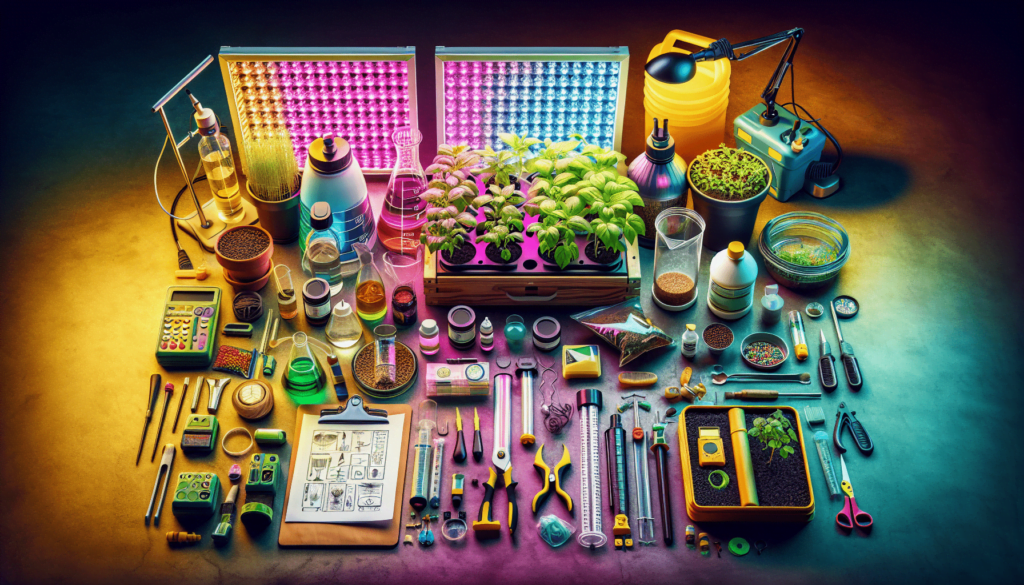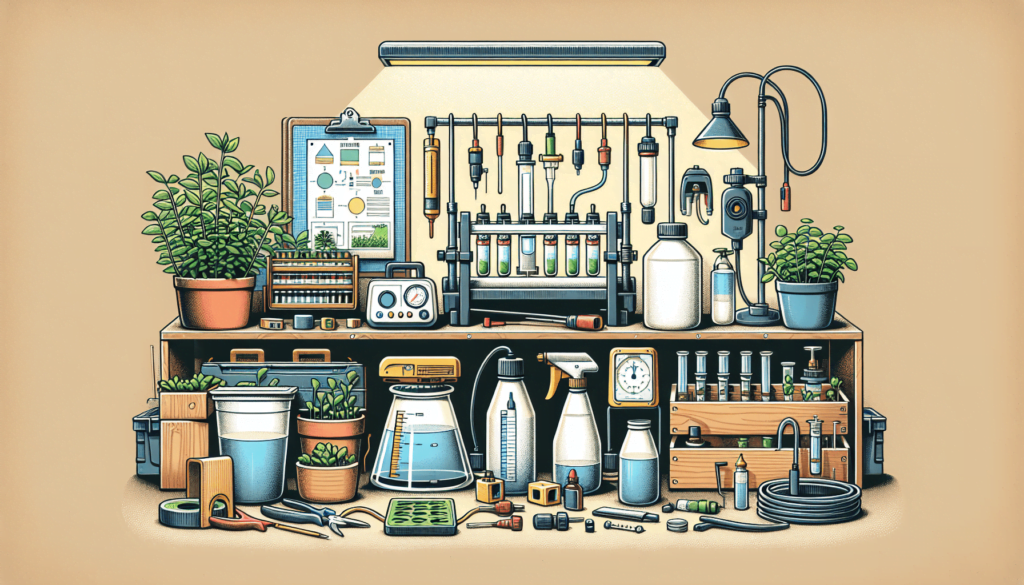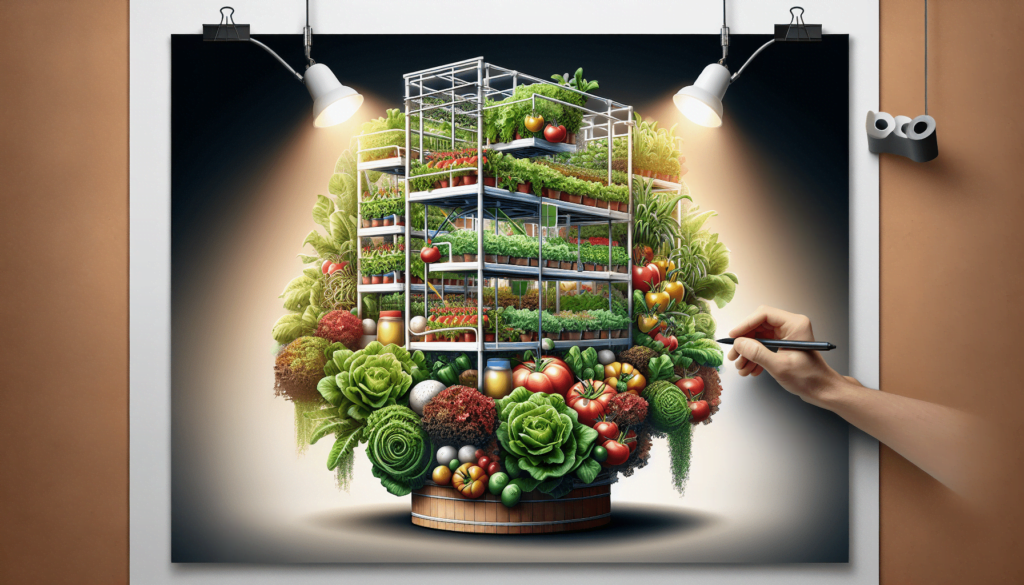Navigating the exciting path of DIY hydroponic projects can be quite an adventure for any gardening enthusiast. From the novice window-planter to the seasoned garden guru, it is vital to equip oneself with the right tools to ensure successful growth and yield. This article offers an inside look into the crucial implements essential for these home-based horticultural ventures. Let us gear up and get ready to guide you through the toolbox, helping you to cultivate showers of thriving, luscious greens in the comfort of your own home!

Hydroponic Systems
Hydroponic systems have quickly become a popular method of gardening and farming due to its sustainability and efficiency. By replacing soil with nutrient-rich solutions, hydroponic systems allow for a clean, versatile, and abundant form of cultivation. We believe in empowering our fellow gardeners with the knowledge they need to create their own hydroponic environments. Let’s dive in!
Essential types of hydroponic systems
In hydroponics, there are six key systems: Wick System, Deep Water Culture (DWC), Nutrient Film Technique (NFT), Ebb and Flow (Flood & Drain), Aeroponics, and Drip System. The Wick System is the simplest form, involving a passive process where nutrient solution is drawn up a wick to the root system. DWC is an active system where plant roots are submerged in a nutrient solution. NFT has a continuous flow of nutrients along a thin film that contacts the roots. Ebb and Flow alternates flooding and draining of the root zone, whereas Aeroponics utilizes a misting system to deliver nutrients to the roots. Lastly, in a Drip System, nutrients are delivered to the root zone via a drip line.
Pros and cons of different hydroponic systems
Each system has its own strengths and weaknesses. The Wick System is incredibly easy to manage, making it suitable for beginners, though it’s not ideal for large, water-hungry plants. DWC systems are inexpensive and straightforward, but the root systems can become waterlogged without sufficient oxygen supply. NFT requires less water and nutrients, but power outages can be devastating. Ebb and Flow is versatile, but overflows are possible without proper management. Aeroponics offers superior oxygenation but requires high maintenance. Finally, Drip Systems are suitable for large-scale setups, but they can get clogged easily.
Selecting a suitable hydroponic system based on your needs
Choosing the right system for your needs depends on factors like your skill level, budget, time commitment, available space, and what kinds of plants you want to grow. For beginners or hobbyists, the Wick or DWC system can be a good starting point. If you’re aiming for a large-scale operation, consider Drip Systems. Remember, there’s no one-size-fits-all solution in hydroponics. Experimenting with different systems can lead to a realm of possibilities in sustainable farming.
Growing Medium
Providing a solid foundation for your plants, the growing medium is an integral part of hydroponic systems. This base, comprised of substances that give physical support to the plant, also facilitates the circulation of essential nutrients.
Important qualities of a good growing medium
A good growing medium should provide support, allow for adequate air exchange, drain excess water efficiently, and not alter the nutrient solution’s pH. In contrast to soil-based growing, it should also be inert — meaning, it should not interfere with the nutrient solution by absorbing or releasing substances.
Various types of hydroponic growing media
The most common hydroponic mediums include Rockwool, Perlite, Vermiculite, Clay Pebbles, Coconut Coir, and Oasis Cubes. Every medium has its own set of pros and cons related to drainage, nutrient retention, price, and reusability, allowing each gardener to find the perfect fit for their specific set-up.
Advantages and disadvantages of different growing media
Coconut Coir, for example, excellently retains water—making it less liable to dry out—but can be prone to compaction, which can impede oxygen exchange. Clay Pebbles drain well and provide good support but may float in deep water culture systems. Understanding the properties and applications of each medium will let you make the most of your hydroponic garden.
Grow Lights
One cannot underestimate the importance of grow lights in hydroponic farming. They help simulate sunlight, enabling photosynthesis, and encouraging beneficial plant growth even in indoor or low-light circumstances.
The importance of grow lights in hydroponics
Grow lights can make or break your indoor garden. Since one of the major factors for photosynthesis — sunlight — is absent in an indoor setup, grow lights serve as a viable substitute. They provide the energy needed for plants to perform photosynthesis, facilitating the production of sugars used for growth and development.
Understanding light spectrums and their impact on plant growth
Light is composed of different spectrums, each with its effects on plant growth. The blue spectrum encourages vegetative growth, while the red light induces blooming and fruiting. Full-spectrum lights cover all stages of plant growth, making them a popular choice among hydroponic gardeners.
Assessing different types of grow lights
There are various types of grow lights available, including Fluorescent Lights, High-Intensity Discharge (HID) Lights, and Light Emitting Diodes (LEDs). Fluorescent lights are cheap and cool-running, making them great for small-scale and beginner gardens, while HID lights produce a lot of light but generate significant heat. LEDs are energy-efficient and compact but can be expensive. Therefore, evaluating your needs and resources is necessary before landing on a decision.
Nutrient Solutions
In hydroponics, the nutrient solution is the lifeblood of your plants. It feeds them with all the necessary minerals needed for growth in a form they can instantly absorb.
Role of nutrients in a hydroponic system
Besides light and water, plants need thirteen essential elements to grow, like nitrogen, phosphorous, potassium, calcium, and magnesium. Your nutrient solution needs to provide all these elements, usually found in soil but absent in a hydroponic reservoir.
Commercial versus homemade nutrient solutions
Commercial nutrient solutions are pre-made mixes, while homemade solutions are custom recipes. Commercial solutions are convenient and balanced, but may not cater to unique needs. Homemade solutions can be tailored to specific plants, but may end up imbalanced or deficient. Therefore, it’s critical to assess your gardening needs and knowledge level before deciding.
Essential nutrient elements for hydroponic plants
Despite the type of solution you use, ensure that it contains the essential nutrient elements in an absorbable form. These include macronutrients — Nitrogen (N), Phosphorus (P), Potassium (K), Calcium (Ca), Sulfur (S), and Magnesium (Mg)— and micronutrients — Iron (Fe), Manganese (Mn), Boron (B), Molybdenum (Mo), Zinc (Zn), Copper (Cu), and Chlorine (Cl).

Water and Air Pumps
In hydroponics, water and air pumps play a significant role. They ensure your plants get a good circulation of nutrient solution and oxygen, key to healthy growth.
Why water and air pumps are essential for hydroponics
Water pumps ensure that nutrient solution circulates around your system, maintaining even access for all plants. Air pumps, on the other hand, oxygenate your nutrient solution. Oxygen is crucial for root health, helping prevent disease and encouraging nutrient uptake.
Different types of water and air pumps
For water pumps, you have submersible and non-submersible options. Submersible pumps sit in your nutrient reservoir, while non-submersible or inline pumps sit outside. Air pumps, usually used with an airstone or diffuser, come in various outputs, measured in liters per hour.
Selecting the right pump based on your hydroponic system
The best pump for your system depends on its size, the type of plants you’re growing, and which hydroponic system you’re using. For instance, larger systems or ones with more water-resistant plants may require stronger pumps. Refer to manufacturers’ guidelines or seek professional advice if needed.
pH and EC Meters
Maintaining the pH and electrical conductivity (EC) of your nutrient solution plays a crucial role in the success of your hydroponic garden.
Understanding the importance of pH and EC in hydroponics
The pH of your solution affects nutrient absorption—too high or too low can lock out certain nutrients. EC reflects the quantity of disolved minerals in your solution. Higher EC indicates more nutrients, but each plant has its tolerance level.
How to use pH and EC meters
Both pH and EC meters are relatively simple to use. They’re dipped into the solution to get accurate, instant readings. It’s important to regularly check and adjust your pH and EC, ensuring they’re within the acceptable range for your specific crops.
Choosing a suitable pH and EC meter for your system
There are many kinds of meters available, varying in accuracy, durability, and price. While simple, cheaper meters might suffice for smaller systems or hobbyists, commercial growers might need more precise and robust devices.
Temperature and Humidity Monitors
Monitoring and controlling the environment is critical for the success of any hydroponics system. This is where temperature and humidity monitors step in.
The role of temperature and humidity in plant growth
Both temperature and humidity play a significant role in plant growth. The ideal temperature varies by plant species, but most prefer between 65-75 degrees Fahrenheit. Humidity can affect plant transpiration–the process of water movement through a plant–which significantly impacts nutrient uptake.
Measuring and maintaining optimal conditions with monitors
Temperature and humidity monitors provide instant readings of your indoor garden’s conditions. Maintaining optimal conditions ensures maximum productivity and prevents potential issues like algae outbreaks or plant diseases.
Best places to install monitors within your set-up
The best place to install these monitors is close to your plant canopy, where they’re exposed to similar conditions. They should be placed in a well-circulated area but not directly in the path of fans or in direct sunlight, as this can result in inaccurate readings.
Timers
In a hydroponics setup, precision in timing can drastically affect the outcome of your crop. This puts timers at the center of a successful gardening operation.
The use of timers in hydroponics for lighting and irrigation
Timers help regulate critical processes in hydroponic gardening. They control when and for how long your grow lights turn on and off, promoting the optimal light-dark cycle. Timers also regulate irrigation frequency, ensuring your plants receive nutrients at regular intervals.
Different types of timers available
There are several types of timers available, each with its own strengths. Basic plug-in timers are usually more affordable but might lack precision. Digital timers, on the other hand, offer more precise control but might come with a higher price tag.
How to properly set and manage your timer
Timers should be set according to the specific needs of your plants. Light schedules vary depending on the growth phase, while irrigation schedules depend on factors like the system type, plant size, temperature, and humidity. It’s vital to regularly check your timer settings, ensuring they’re accurate and functioning correctly.
Pruning Tools
Proper plant maintenance is crucial for efficient hydroponic farming. This is where pruning tools come in handy.
Importance of pruning in hydroponics
Pruning is an essential practice in hydroponics. It helps maximize yield by directing a plant’s energy towards producing flowers and fruits. Regular pruning also helps maintain optimal plant health by removing diseased or pest-ridden leaves and stems.
Various types and uses of pruning tools
There are a variety of pruning tools for different jobs, including scissors, shears, pruners, and knives. Specific tools can be used for various tasks—for example, scissors are great for fine trimming, while shears and pruners are better for cutting branches and woody stems.
Maintaining and cleaning your pruning tools
Keenly maintaining and cleaning your pruning tools help extend their life and prevent the spread of diseases across your plants. Always clean them before and after use, and sharpen regularly to ensure clean cuts, minimizing stress to your plants.
Protective Gear
Last but not least, don’t forget the importance of protective gear when working on your hydroponic setup.
Why protective gear is essential in hydroponics
Protective gear is crucial to avoid accidents and maintain hygiene in your hydroponic garden. It can prevent injuries from sharp tools, prevent direct skin contact with nutrient solutions, and keep your system free from harmful bacteria or contaminants.
Different types of protective gear
Common types of protective gear include gloves, eye protection, and respirators. Gloves keep your hand safe and clean, while eye protection prevents splashes from nutrient solutions. Respirators or masks protect against potentially harmful particulates in the air.
Guidelines for using and maintaining protective gear
Always make sure that your protective gear is in good condition before use. Clean them after each use, and replace when signs of wear or damage appear. Finally, always remember that prevention is better than cure—it’s crucial to prioritize safety while performing your tasks in your fantastic hydroponic setup.
Forum
Got something to share or a question to ask? Jump in and start a conversation! Whether it’s tips, advice, or just sharing your experiences, we’d love to hear from you. Don’t be shy—your input could inspire or help someone else!- This forum has 1 topic, and was last updated 10 months, 2 weeks ago by .
- Topic
- Voices
- Last Post
- You must be logged in to create new topics.


